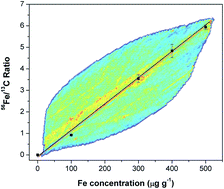Application of laser ablation (imaging) inductively coupled plasma mass spectrometry for mapping and quantifying Fe in transgenic and non-transgenic soybean leaves
Abstract
Laser ablation inductively coupled plasma mass spectrometry is used for determining Fe in leaves of transgenic (variety M 7211RR) and non-transgenic (variety MSOY 8200) soybean, grown for 21 days in a growth chamber at controlled temperature (27 ± 0.1 °C) and photoperiod (12 h). The same technique, but in the imaging mode, is also employed for acquiring the spatial distribution of Fe in leaves of both the varieties. For attaining both proposals, different parameters, such as RF power, carrier and auxiliary gas flow rates, dynamic reaction cell flow rate, RPq, laser intensity, spot diameter, frequency and scan speed, are optimized. The accuracy of the laser ablation method is assessed by comparing the results (from ratios between 56Fe and 13C, used as an internal standard) obtained from pellet samples (200 mg of the certified reference materials–NIST SRM 1515 and 1573a at a pressure of 7 psi), or prepared pellets from transgenic and non-transgenic soybean leaves, with those from digested samples. No differences at 95% confidence levels are found. Although Fe concentrations are similar in transgenic and non-transgenic leaves, their spatial distribution is significantly different. Fe is homogenously distributed in the whole transgenic soybean leaf, while this element is greatly concentrated in the main vein and nerves of the non-transgenic leaf. Taking into account all the variables that are controlled during the experiment, this result indicates that genetic modification might be responsible for altering the Fe distribution in the soybean leaves.


 Please wait while we load your content...
Please wait while we load your content...